

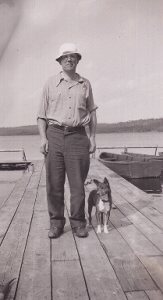
I had always been a "cat person" until my husband began working unusual hours, frequently at night. For the first time in my life, I considered owning a dog to keep me company. My requirements: a breed that is small, clean, quiet, requires little or no grooming, and has a playful disposition. A bell went off in the dim recesses of my memory. Ah, yes, my great-uncle had just such a dog -- a Basenji!
This is a picture of my Uncle Stew and Pooch, taken sometime in the late 1940s or early '50s. He did not live near me, and I would have been too young to remember anyway, but family members still talked about Pooch years later. His most memorable characteristic, apparently, was that he did not bark. And thus began my adventures with the Basenji.
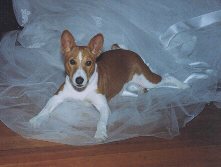
The Basenji is one of the most ancient breeds of dog. Originating on the continent of Africa, the Basenji has been venerated by humans for thousands of years. Basenjis can be seen on stele in the tombs of Egyptian pharoahs, sitting at the feet of their masters, looking just as they do today, with prick ears and tightly curled tail. This was born out by the announcement in 2004 by canine genome researchers that two branches of the canine family tree were the earliest to diverge from the wolves. One branch includes the oriental breeds Shar-Pei, Shiba Inu, Chow Chow and Akita; and the other includes Siberian Husky, Alaskan Malamute, Afghan Hound, Saluki...and the Basenji.
The Basenji had all but disappeared from civilization when it was rediscovered in the Congo region of Africa in 1895. There, the Basenji was highly prized by natives for its intelligence, courage, speed, and silence. They were invaluable assistants to the hunt, chasing wild game into nets for their masters. The Azande and Mangbetu tribes from the northeastern Congo region describe Basenjis, in the trade language of Lingala, as "embwa na bwasenji". Translated, this means "dogs from when we were wild" or "dogs from long ago".
Several attempts were made to bring the breed to England, but the earliest imports succumbed to disease. It was not until the 1930s that foundation stock was successfully established in England, and thence in the United States. So it is that nearly all the Basenjis in the western world are descended from these original imports. For a fascinating account of the importation of the Basenji from Africa, read The History of the Breed, a document submitted to the AKC in support of reopening the stud book for the purpose of enlarging the gene pool.
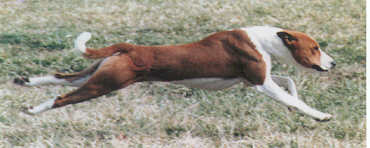
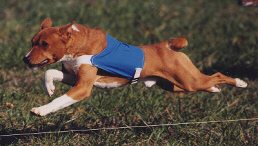
The Basenji is classified as both sighthound and scenthound. What this means to the Basenji owner is that the dog is highly responsive to visual cues and is very prey-driven, so great care must be taken to keep him safe. The Basenji will chase a cement truck as eagerly as he will a squirrel, and a disproportionate number of Basenjis meets their death in the road. The Basenji is also regarded as an excellent gamebird dog due to its ability to pick up a scent at 80 yards. (Incidentally, it can also smell a cookie or a piece of pizza at 90 yards!) Because the Basenji is a graceful and athletic dog, it is very successful in agility and lure coursing trials.
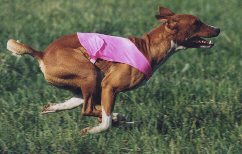 According to the AKC standard, the Basenji's gait is "effortless, resembling a racehorse trotting full out." Author Susan Coe (The Basenji Out of Africa to You) notes that the comparison is valid, referring to some of the same characteristics of movement: reach, drive, balance, level topline, glide and head carriage. Note those elements in these photos.
According to the AKC standard, the Basenji's gait is "effortless, resembling a racehorse trotting full out." Author Susan Coe (The Basenji Out of Africa to You) notes that the comparison is valid, referring to some of the same characteristics of movement: reach, drive, balance, level topline, glide and head carriage. Note those elements in these photos.
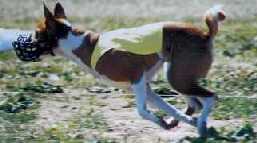 Many Basenji fanciers believe that encouraging the sport of lure coursing is the best way to retain those defining qualities in the breed. It is thrilling to watch a Basenji run, whether he is participating in a lure coursing field trial or just running for fun in some other safe place. Dogs are often muzzled when coursing to help them remain focused on the lure, and also to aid in catching them at the end of the race! (Photos of Baron, aka Sherwood's Red Baron, LCM, CGC, courtesy of Robyn Dubbert of Sherwood Basenjis; Photo of Nicky in yellow jersey, aka FC Sherwood's In the Nick of Time, SC, FCh, courtesy of owner Lisa Voss.)
Many Basenji fanciers believe that encouraging the sport of lure coursing is the best way to retain those defining qualities in the breed. It is thrilling to watch a Basenji run, whether he is participating in a lure coursing field trial or just running for fun in some other safe place. Dogs are often muzzled when coursing to help them remain focused on the lure, and also to aid in catching them at the end of the race! (Photos of Baron, aka Sherwood's Red Baron, LCM, CGC, courtesy of Robyn Dubbert of Sherwood Basenjis; Photo of Nicky in yellow jersey, aka FC Sherwood's In the Nick of Time, SC, FCh, courtesy of owner Lisa Voss.)
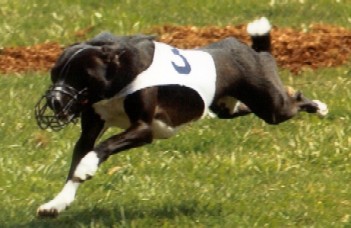 Moxie (AB Keen Midnite Impatiens, JC, SGRC2) is the #1 Basenji in the 2002 LGRA racing season with 38 National points, and is #4 All Breed. As of February 2003, she has not lost a race in over three years of racing. Another "first": it is the 3rd year Moxie placed in the All Breed Top Ten. She is the #5 Lifetime Point Earner in LGRA (all breeds) and is separated from #4 by only .05 points!
Moxie (AB Keen Midnite Impatiens, JC, SGRC2) is the #1 Basenji in the 2002 LGRA racing season with 38 National points, and is #4 All Breed. As of February 2003, she has not lost a race in over three years of racing. Another "first": it is the 3rd year Moxie placed in the All Breed Top Ten. She is the #5 Lifetime Point Earner in LGRA (all breeds) and is separated from #4 by only .05 points!
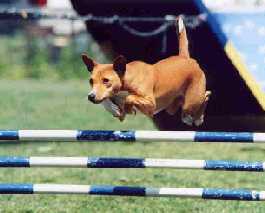 The Agility Trial, arguably the fastest growing canine sport, is basically a race against the clock: the handler has a set amount of time to direct the dog, off-leash, through a predetermined obstacle course. Common obstacles include the A-frame, dog walk, see-saw, broad jump, bar jumps, weave poles, and open and closed tunnels. Dogs compete against others of similar height within a fixed number of height divisions. Handlers may give an unlimited number of commands, but may not touch his dog or the equipment as he navigates the course. As the dog and handler advance to higher levels of competition, the courses increase in complexity and require ever greater coordination and timing.
The Agility Trial, arguably the fastest growing canine sport, is basically a race against the clock: the handler has a set amount of time to direct the dog, off-leash, through a predetermined obstacle course. Common obstacles include the A-frame, dog walk, see-saw, broad jump, bar jumps, weave poles, and open and closed tunnels. Dogs compete against others of similar height within a fixed number of height divisions. Handlers may give an unlimited number of commands, but may not touch his dog or the equipment as he navigates the course. As the dog and handler advance to higher levels of competition, the courses increase in complexity and require ever greater coordination and timing.
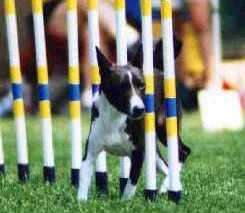
While the Basenji's athleticism makes him a natural in this arena, his stubborn independence may be a trial of a different sort for the handler! Nevertheless, Basenjis are increasingly successful in Agility. The photo above shows Abbey - Ch Alamar Selby Abbeygale, JC, FCH, NA, GRC - clearing a triple-bar jump. Her intensity and focus are delightfully apparent. To the right is Khayman, aka Khayman Goes Ninety, JC, CD, FCH, OA, OAJ, NAC, NJC, CGC, as he negotiates the weave poles. (Photos courtesy of Christine Morgan of Keen Basenjis in River Falls, Wisconsin. Photo of Abbey by Tien Tran Photography)
The Basenji is considered a "primitive" breed due to its independent nature, and is therefore less well-suited to obedience training than many other, more common, breeds. This is one of the reasons the Basenji should not be chosen without careful consideration. If you are looking for a dog that is naturally obedient and attuned to his master, consider a different breed. Basenjis are quite capable of earning obedience titles, but it is a testament to the diligence and consistency of the trainer, not to the Basenji's innate desire to please! The Basenji, like the domestic cat he resembles in so many endearing ways, will very often do as he pleases, regardless of his owner's wishes! Highly intelligent, the Basenji is very curious and easily bored. If untrained, left alone, and not given adequate exercise (a tired dog is a good dog!), the Basenji is capable of unbelievable destruction. The breed demands the utmost in the time and patience of its owners. A sense of humor is essential, as well.
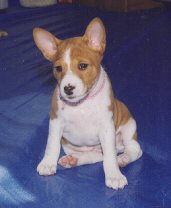
Meet RUBY, officially known as Cinnabar's African Jewel. She was born 19 January 1997, although we didn't meet her until she was eight weeks old. It was a case of love at first sight, and we counted the hours until she came to live with us two weeks later.
We had done our homework; we thought we knew what we were getting ourselves into. We quickly realized how naive we were.
Ruby was a living terror the first seven months of her life with us; indeed, there were days, early on, when I thought we had made a terrible mistake, and contemplated returning her to the breeder. Basenji puppies are either "off" or "on". When they're "on", they are into everything they shouldn't be, and you'd better be right behind them! Anticipate that no matter how vigilant you are, your basenji puppy will leave a reminder of its puppyhood on some cherished possession.
As Veronica Tudor-Williams, in her 1946 book Basenjis The Barkless Dogs, wrote:At times no dog can be naughtier than a Basenji, but no dog has brought apology to a finer art. How can one be cross with an animal which lies on its back with both hands folded over its eyes, or stands on its head turning somersaults, or peeps round the door watching the reactions of an indignant owner, yodelling loudly when it finds the moment of retribution can no longer be averted?"
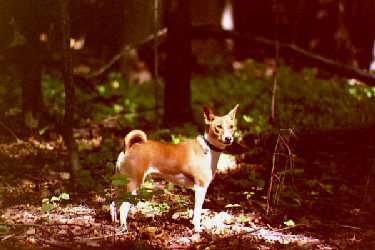 |
This is Ruby on a romp in her favorite woods in late summer 1999. She loves to run free, but has the opportunity to do so only in the woods and fields behind our home, far from the dangers of the road. ©by John Kosche Share with me your doggie dreams. Safe in my warm bed. |
 |
Basenjis can get into a lot of mischief! They have a peculiar fondness for toilet paper, tissues, and cotton swabs, and a particular dislike of being ignored. This episode occurred while I was busy at the computer. ©by John Kosche Barkless dog with curly tail Came to eat your socks. |
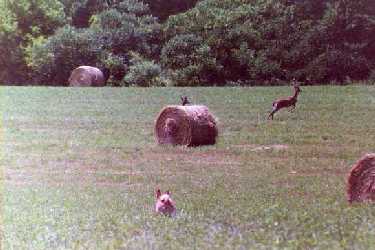 |
Ruby often flushes game on our walks in the wild: wild turkeys, woodcocks, pheasants, and grouse. The fact that they fly above her head does not dissuade her from running along beneath them, just in case they decide to drop out of the sky. Here, she has just spied two white-tailed deer. She didn't catch them, but she sure gave a merry chase! (We try to discourage deer chasing, as it is illegal.) |
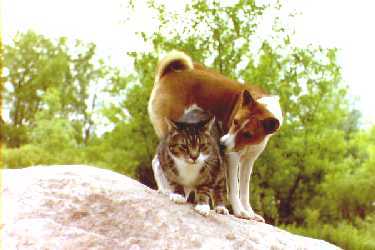 |
Ruby's best friend and housemate is a 14-year-old cat named Larry. He let Ruby know up front that he was a force to be reckoned with. They play hard, but are judicious in use of teeth and claws. They often nap together in Ruby's crate. |
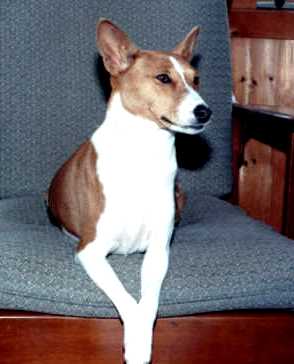 |
The basenji is an elegant creature, both in motion and at rest. Note the inscrutable expression on Ruby's face. If she were more alert here, the wrinkles on her forehead, a distinctive characteristic of the breed, would be more apparent. Basenjis are also fastidious groomers - they even wash their faces in cat-like fashion! |
 |
|

